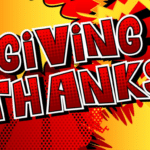CLICK HERE to download this blog as a PDF: Your Calendar for Successful Year-End Fundraising.
It’s time to get on top of your year-end fundraising. For many organizations, December is go big or go home time — the month that makes it all work.
Is this year different?
There’s no question this COVID-19 year is atypical for almost all fundraisers. The biggest thing is what has happened for those who stayed active through the spring and summer: Most had record-breaking fundraising results. Many hit their full 2020 revenue goal in April or May.
An obvious next question is this: Has December already happened? Did donors simply move their year-end giving into the spring in response to the pandemic?
Answer: Almost surely not. Don’t second-guess your donors, assuming they won’t give. Field a strong year-end campaign for best results.
Here’s a suggested calendar to your end-of-year fundraising. Your exact dates will vary, depending on a lot of factors, but I hope this gives you a good starting place.
I hope it helps! CLICK HERE to get this blog as a PDF: Your Calendar for Successful Year-End Fundraising.
Jeff
SEPTEMBER & OCTOBER: Start early
There are two distinct reasons giving goes up at the end of the year:
- Offers that are specifically connected to the Holidays — Thanksgiving or Christmas meals, gifts for kids, etc. — are very compelling to many donors.
- The Holidays (basically US Thanksgiving up to New Year’s) are themselves reasons to give, even when there’s no connection with the Holidays themselves.
Your organization may have #1 as a factor for donors, but for sure you have #2.
If you have Holiday-related offers, start your Holiday fundraising early. Like early September. Maybe even earlier!
September is the sweet-spot for most gift-catalog fundraisers. “Get ready for the Holiday” appeals can do very well in this time.
It’s also the time for the Jewish High Holidays (Rosh Hashanah, Yom Kippur, Sukkot, Simchat Torah), which this year start mid-September and go well into October.
NOVEMBER: Thanksgiving (US only)
Thanksgiving is an important holiday in the US, with deep emotional roots for many people. It is not far behind Christmas as an occasion for donating. It falls on the late side this year, November 26 (it ranges from the 22nd to the 28th).
If you’ve never done a Thanksgiving appeal, consider doing one this year.
The topic: Thankfulness. That’s right — remind your donors of the power and importance of being thankful and let them know that charitable giving is a great way to express gratitude. Connect gratitude with your cause in whatever way works.
An appeal like this can be very powerful when it authentically connects with the donor.
NOVEMBER/DECEMBER: Giving Tuesday
An email and/or social media campaign centered around Giving Tuesday can be quite strong. For many organizations, it is amongst the top digital fundraising campaigns of the year.
If you are cynical about Giving Tuesday, I don’t blame you. It’s an unusual occasion, but it continues to do well for a lot of organizations. It has somewhat successfully connected itself with the cluster of named days after Thanksgiving (Black Friday, Cyber Monday, etc.). The motive for donors seems to be “give today because everyone is giving.”
A minimalist Giving Tuesday campaign would have three parts:
- Monday: “Get ready for Giving Tuesday! Or get a jump on it and give now!”
- Tuesday: “Join the Giving Tuesday movement and donate now!” (Possibly more than one message this day.)
- Wednesday: “It’s not too late to make a Giving Tuesday donation!”
Some organizations start their Giving Tuesday campaign on the day after Thanksgiving.
Decision: “Holiday” or “Christmas”
Which do you and your donors celebrate? Unfortunately, in the US, this has become a bit of a political football. Fortunately, not many of your donors are active in that debate. What your organization chooses to call the season depends on the heritage and culture of your organization and your donors.
Just to be clear, “the Holidays” as a whole is a cluster of celebrations, most of them in December, including:
- Hanukkah (starts December 10 this year)
- Winter Solstice (December 21)
- Christmas Day (December 25)
- Kwanzaa (December 26)
- Ramadan (migrates throughout the year; it won’t be in December until 2030)
- New Year’s Day
- Some Orthodox Christians celebrate Christmas on January 7
There’s also a handful of Christmas-related minor holidays celebrated by various communities:
- Nicholas Day (December 6)
- Lucia Day (December 13)
- Las Posadas (December 16-24)
- Epiphany (January 6)
However you approach it, the Holidays are a potent giving season. Most traditions include gift-giving, and many also emphasize kindness and charity at this time of year.
Use faith imagery and language as appropriate. If not, do use secular images, like candy canes, Santa Claus, holly, etc. These things remind donors of their own connection with the Holidays and can do very well.
LATE NOVEMBER – EARLY DECEMBER: Year End
Most fundraisers have a campaign that combines the Holidays with the Year End. This appeal usually mails just before or just after Thanksgiving, to assure the mail will arrive in the first part of December.
In many countries, a Year End appeal is strong because December 31 is a tax deadline. Recent changes to the tax laws in the US mean far fewer donors will bother to claim any charitable tax deductions, but it is an important deadline to stress anyway!
I don’t need to tell you this, but someone may need the reminder: Just because it’s a Holiday/Year End appeal doesn’t mean you can skip the fundraising basics! You still need a strong and specific call to action.
The fact alone that it’s a “giving time of year” is not the reason people give. They’re just more likely to think about giving than at other times.
MID-DECEMBER: Year End Follow-Up
Here’s a way you might increase that year-end campaign revenue: Add an extra appeal a week or two after the Year End appeal, using the same topic as the Year End appeal. Keep it simple, and scale back on the donors you mail — such as current (gifts in the last 12 months only) and possibly remove low-dollar donors.
This doesn’t work for everyone, but it’s an important appeal for many.
Another possible follow-up activity: A postcard, sent to donors who have made online donations, urging them to give online.
DECEMBER 26-31: Calendar Year End campaign
In the US and other countries with a December 31 tax deadline, the final week of the year is often by far when most giving happens. Do not neglect it!
Email several times, starting December 26. As often as every day. And email twice on December 31, the biggest online giving day of the year.
That’s a fundraiser’s year end! Share what you’re doing this year, what you’ve done in the past, and what has (and hasn’t) worked for you at this critical time.
CLICK HERE to download this blog as a PDF: Your Calendar for Successful Year-End Fundraising.
Want to get every single one of these appeals right? Join The Fundraisingology Lab by Moceanic. It’s a community of fundraisers who support each other by sharing information, ideas, and encouragement. Members also have access to the best tools, time-saving templates, practical courses and other great stuff to help you survive and thrive this year-end. Find out more now.
Related Blog Posts:
- VIDEO: How to Feel the Holiday Season When It’s Still Far Off
- VIDEO: How to Plan Your Christmas Appeal in Advance for Maximum Impact
- Holidays That Boost Donor Giving — and the Rest You Can Ignore










